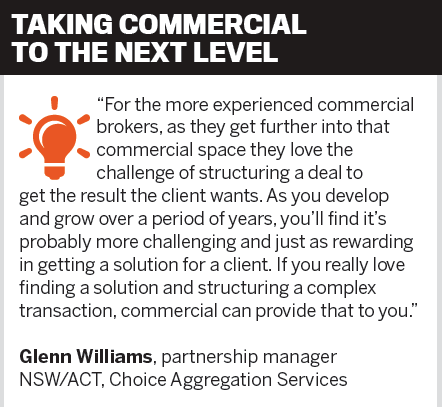Here's how to take your first steps into commercial finance and how your BDM can guide you along the way
Are you a Top 10 Commercial broker? Take two minutes to apply online here
Ever considered adding commercial lending to complement your residential portfolio but were stumped on where to start?
To help make this process less daunting, MPA spoke to a highly experienced business development manager, as well as a broker who’s recently taken the leap into the commercial space, to get their views on how to make diversification painless.
Glenn Williams, Choice Aggregation partnership manager for NSW/ACT, routinely specialises in helping both new-to-industry and experienced residential brokers diversify in this direction, and has seen what works best and the challenges involved.
Our broker Louisa Sanghera started broking three years ago, with 30 years in the finance industry behind her. She launched NSW brokerage Zippy Finance in 2015 and stepped into the commercial space five months ago.
We hope you’ll find their insights useful and that their practical advice will help you get started in the commercial space.
From the BDM
The most successful commercial brokers often have a few things in common, says Williams. They have a team of support staff in their office, and have forged strong ties with accountants, planners and key commercial funders.
It therefore follows that the time it takes to get a foothold in the commercial space depends on what level of experience you’re starting from. Williams says a new-to-industry broker may take a few years to build into the commercial space, whereas it would be quicker for a broker coming from a commercial banker or bank manager background. Established residential brokers could introduce commercial finance into
their business within six to 12 months.
Brokers need to particularly careful about keeping up with what commercial lenders are looking for, says Williams, such as lender policies and maximum loan amounts against security. “Commit to education; embrace all the opportunities out there provided by the lenders and the aggregators to attend commercial workshops, business development days and training programs.” A broker’s BDM can arrange training sessions with their lender partners and tailor them to suit the broker’s skill set.

“By highlighting the clients that are self-employed, you then know that they may need to engage in cash flow lending or commercial funding to buy a property for their business” Glenn Williams, Choice Aggregation Services
When it comes to finding commercial clients, Williams says brokers can spread the word about their new offering to their referrers but should also utilise opportunities within their existing client base, such as looking at how many clients are self-employed.
“By highlighting the clients that are self-employed, you then know that they may need to engage in cash flow lending or commercial funding to buy a property for their business,” Williams says. The broker can then look at whether there are any commercial debts, facilities or assets that they can then bring up in conversation with their client.
Williams notes that leasing with self-employed clients is also a good place to start. “Leases are probably an easier way to sell, and they’re quick turnover – it’s quick to lodge the application and you get your money the day after settlement. So it’s a quick way to increase cash flow to your business as well as start stepping towards commercial.”
Commercial lending can be split into three tiers, Williams explains: there’s small business lending up to $1m, which can take longer than a standard home loan but is quicker than some commercial deals; commercial lending over $1m; and development funding for more experienced commercial brokers. As Williams puts it, “if [brokers] get in the small commercial lending space it’s not unlike a residential-type facility to start that process”.
Williams says there are two ways of getting accredited with a lender for business–spot and refer, or writing the transactions and submitting them to the lender. If a broker starts with spot and refer, their BDM can introduce them to appropriate lender partners for writing transactions/further education so they can reach the stage of writing the deals themselves, which naturally involves a better commission split.

A broker’s database is crucial. “Where we spend a lot of time developing and growing is getting the brokers to see there is opportunity in the commercial space, accessing their database to see the opportunities, then letting their clients know that they’re in that space and making sure they engage the right partners within the aggregation business to submit those deals to.”
From the broker
Five months in, Sanghera has found her experience in commercial finance very interesting. “It’s lovely helping people get their dream homes and that side of it, but business is really interesting – it’s interesting learning how different businesses actually work.”
Doing spot and refer to get an idea for commercial loans, Sanghera is now starting to write some of the deals herself. Her brokerage already offers residential, asset and car finance, and it seemed like the right time to tackle the commercial space. “Because I’ve got the time, I’ve got the right staff in place, I’ve got the right systems in place and I’ve built my knowledge over the last few years, it’s the right time for me to do it myself.”

“Spot and refer is a great way for brokers to get involved in commercial” Louisa Sanghera, Zippy Finance
Initially choosing to spot and refer because she didn’t have the time to write the transactions herself, Sanghera says there is a downside to it. “You do lose control of your client to a certain extent … potentially you could lose control over future borrowings,” she explains, as the client is referred on – but it is a great way to get involved.
“Just by doing spot and refer [brokers] can speak to the business managers, they can hear what they’re doing – the business manager I first worked with used to show me what she was doing so I could see how she was structuring it.”
Sanghera also sought out a business coach to help her break into the space: an ex-broker, ex-BDM and strong commercial lender. But she says this was her choice to take on a coach and it wouldn’t be a necessity for brokers looking to add commercial to their business, but brokers should seek out the help of BDMs. “The BDMs are enough for you to go and do the commercial lending, absolutely.
“The BDMs are there to help you structure deals and there to educate you. I think a lot of brokers feel they don’t want to take up the BDMs’ time to sit down and go through applications with them, but that’s what they’re there for.”
Sanghera also chose to outsource processes to free up more time for commercial deals.
“I think a lot of brokers spend too much time doing their own processing, trying to save money – I think if they look at the bigger picture and spend that money on processing, it frees their time up so that they can get out and bring in more business. But a lot of brokers are reluctant to spend money on external processing, so they sit at desks for hours just processing paperwork.
“We need to be doing the complex, structured deals, getting out there, finding the business and letting other people do the paperwork for you – that’s the way I’m doing my business anyway, and it’s working for me.”
If you’re a broker thinking about diversifying into commercial loans, we hope this feature has shown you the steps it will involve through the eyes of a broker who has taken on the challenge–and that your BDMs are there to support and guide you throughout the process.
Whether you are looking to spot and refer commercial loans or are set on tackling development funding, there is no doubt commercial lending can be a challenging and exciting addition to your business offering.
Are you a Top 10 Commercial broker? Take two minutes to apply online here
MESSAGE FROM OUR SPONSOR
For brokers whose core business offering has long been in residential, branching out into commercial finance can seem daunting. But the new revenue streams commercial finance presents are compelling, and there are many small yet impactful steps brokers can take to incorporate commercial lending into their businesses.
Of course, the help of a quality aggregator can be an invaluable addition. Choice works closely with brokers to help them succeed, and part of that is working with brokers to help them diversify their businesses. We are seeing a groundswell of brokers starting to make the move into commercial finance, recognising it as a powerful way to strengthen client relationships by being able to take care of more of their needs.
I hope this feature offers some helpful insights for all brokers thinking about making their first step on the commercial finance journey.




